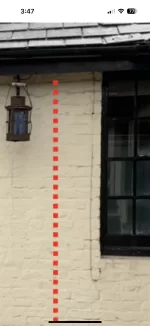I've been slowly renovating an old 1800s listed building which was suffering from a lot of damp. I've managed to combat a lot of the damp in the house by installing French drains, fixing gutters, reverting to Lime plaster but there's one room which is completely throwing me and not sure how to move forward.
There is a damp line running along the centre of the bedroom wall which is an internal wall running at right angles to the exterior wall.

Floor plan of the house showing the damp wall

A picture of the exterior wall with the position of the internal wall. Internal wall butts up against the window at the right side of this picture

Exterior ground levels are low. Gutters have been checked. Loft area above is dry with no leaks. Weather seems to make no difference. It's there when it's sunny and dry outside as well as when raining. Before decorating I removed the wallpaper which shows signs of previous works on what I assume were to combat damp

Any ideas what investigation I should do next and what the likely fix would be?
There is a damp line running along the centre of the bedroom wall which is an internal wall running at right angles to the exterior wall.

Floor plan of the house showing the damp wall

A picture of the exterior wall with the position of the internal wall. Internal wall butts up against the window at the right side of this picture

Exterior ground levels are low. Gutters have been checked. Loft area above is dry with no leaks. Weather seems to make no difference. It's there when it's sunny and dry outside as well as when raining. Before decorating I removed the wallpaper which shows signs of previous works on what I assume were to combat damp
Any ideas what investigation I should do next and what the likely fix would be?

